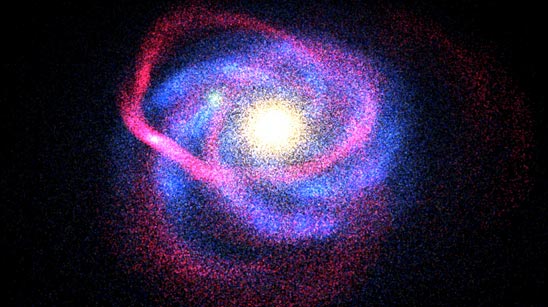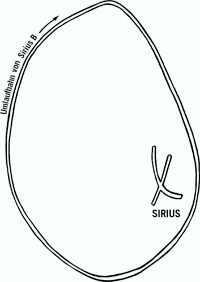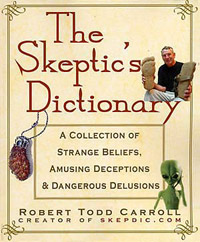Could a remote African people have gained esoteric knowledge about the sky without having telescopes? Were aliens, lost technology or something else entirely involved? In this week’s eSkeptic, Liam McDaid examines these claims.
Liam McDaid is Astronomy Coordinator and Professor of Astronomy at Sacramento City College. He also gives public talks on astronomy and related fringe topics to international audiences. Liam is the author of Urban Astronomy and is a Senior Scientist for Skeptic.
Below: The Canis Major Dwarf Galaxy (discovered in 2003) is the nearest known galaxy to the centre of the Milky Way. Found in the constellation after which it is named, it is about 25,000 light years from the sun and 42,000 light years from the centre of the Milky Way. It is also the home of the brightest star in the night sky, Sirius A. (Copyright: R. Ibata (Strasbourg Observatory, ULP) et al., 2MASS, NASA)

Legends of the Dogon
Belief in a Long-Solved Mystery Resurfaces
by Liam McDaid
MANY SKEPTICS WOULD LIKE TO THINK THAT ONCE SOMETHING IS debunked, that will be the end of it. Readers of Skeptic are not so sanguine. Some pseudosciences such as homeopathy and free energy never die. Although we can occasionally claim victory (are there any alchemists left?), many debunked issues keep rising from the dead like vampires springing from their tombs. Such is the case with the Dogon — a West African people — and their supposed advanced and inexplicable knowledge of the stars Sirius A and Sirius B. Sirius A is the brightest star in our sky. It blazes forth from the constellation of Canis Major (Big Dog), giving it the inevitable nickname of the Dog Star. The legend of the Dogon’s astronomical precociousness first appeared on the radar in the 1970s. It was popularized in an episode from the In Search of… television series narrated by Leonard Nimoy. A recent newsletter from my local astronomy association still found the Dogon and their mysterious knowledge of Sirius B worth mentioning.

After being surprised that an astromomy association would, after all this time, bother to publish such an article, I did a web search and found that in 1997 Robert Temple published a second edition of the book that started it all — The Sirius Mystery — in which he addressed none of the main criticisms that had been directed against the first edition, published in 1976. The immunity of pseudoscientists to criticism is well known to skeptics, yet I was curious. I did more searching and found that for the keywords “Dogon” and “Sirius B”, almost 1000 websites were listed. Of those websites, over 400 had been updated within the last three months. The good news is that two of the first five entries were from skeptical websites (CSICOP and Bob Carroll’s Skeptic’s Dictionary). The bad news is that the pseudoscience websites were in seventeen different languages. It seems that Temple’s ideas are still popular among practitioners of pseudoarcheology, as well as with the general public. A review of the astronomical, cultural, and anthropological sides of this issue might be timely.
The basic thesis is this: the Dogon (who live in the African nation of Mali, near the border with Burkina Faso) allegedly have long possessed arcane astronomical knowledge that should have been impossible for them to discover without modern telescopes. They know about the existence of the star Sirius B, a companion star to the brightest star in our sky, Sirius A. Since Sirius B is a very dense white dwarf star about the size of Earth, it can only be seen in dark skies with medium-sized telescopes. The Dogon also hold a big sigui ceremony every 60 years, which some interpret as representing the period of time it takes Sirius B to go around Sirius A. How did the Dogon obtain this knowledge?
This is a complicated issue, because several special interest groups each claim the Dogon for their own. One group says the Dogon got their information from aliens from the Sirian system called Nommos. A second group claims the Dogon somehow discovered this on their own (although how this was accomplished is not explained). The third explanation is that they learned the information from Europeans or in European schools.

Figure 1. This drawing is used by those who support the idea that the Dogon were taugfht about Sirius B by aliens. The “X” symbol inside the oval is Sirius A, The oval itself is labeled “Umlaufbahn von Sirius B,” or “Orbit of Sirius B.” Pretty convincing. Except that this isn’t the original Dogon drawing.
Let’s start with the first idea, proffered by Robert Temple.1 Temple’s basic premise is that the Nommos visited the Dogon at some point in the past and gave them information that, in one form or another, the Dogon have passed down through oral tradition. Some of this information has been selectively interpreted by Temple to support his claims. For example, he claims that the Dogon have a drawing like the one in Figure 1.
Temple’s response to criticism has so far been evasive. The introduction to his second edition is so full of paranoid theorizing,2 that although it is quoted extensively and interpolated with favorable comments by Michael Bara (or possibly Richard Hoagland), the most extreme conspiracy claims are omitted.3
It is important to look at the assumptions and implications of the claims made about the Dogon. One of the problems the UFO crowd has is providing an answer to the question of where the aliens who visit us come from. The Pleiades are sometimes mentioned, but this is not possible. The stars in this group are too young — only a few tens of millions of years — for planets with life and civilization to have developed.
Zeta Reticuli 2 (with about the same temperature and mass as the Sun) is another candidate. The inspiration for this claim was a star map produced by Betty Hill while under hypnosis. She claimed an alien starship commander had originally shown it to her. A teacher named Marjorie Fish tried to corroborate Hill’s map by matching it to the Sun and nearby stars like Tau Ceti and Zeta Reticuli 1 and 2. But Fish’s map used an arbitrary viewpoint in space. Fish’s map and Hill’s map look similar only because the lines connecting the stars look the same. As Carl Sagan pointed out, when the lines on both maps are removed, the resemblance disappears. Sagan further commented that he was surprised, given the freedom of viewpoint that Fish used, that her map didn’t match the Hill map better!4

Figure 2. This is the original Dogon drawing. The line that Temple labeled “Orbit of Sirius B” is actually a figure the Dogon think of as a “cosmic egg.” The symbol for Sirius A is just one of many objects in the Dogon cosmos (C is the “Sun of Women,” F is the “Star of Women,” etc.). The diagram is only convincing as a representation of Sirius B orbiting Sirius A when most of the original symbols are eliminated.
What about Sirius? It has a mass of 2.35 times the mass of the Sun. This means that it will have a lifetime on the stellar Main Sequence, which is where stars spend 90% of their lives, of about 1.2 billion years. By comparison, our own Sun was that old 3.4 billion years ago. The oldest traces of life on Earth go back to about that time. Obviously, no Earth-based species was flying to other stars back then!
Even if you allow for a much higher biological mutation rate on any Sirian planet compared to the Earth, it still isn’t enough time. Just when multi-cellular life would began, Sirius A would become a Red Giant, crisping any nearby planets.
On top of that, there is another star, Sirius B, orbiting at an average distance of about 20 AU (1 AU is the distance between the Earth and Sun). Because Sirius B moves from 8 to 31 AU distance from Sirius A, it is unlikely that planets orbiting Sirius A would have stable orbits. Worse still, hundreds of thousands of years ago, Sirius B was a dying red giant. This would have wreaked havoc on the climate of any planets orbiting Sirius A. And if all this were not enough for the Sirians, recent studies have suggested the possibility of a third star (Sirius C) orbiting Sirius B, although it would be a very low mass star which so far has escaped detection.5 Stable planetary orbits may be very hard to find in the Sirian system. Temple sees the existence of Sirius C as a vindication of one of his claims, although it should be remembered that multiple star systems are common (like Alpha Centauri, with its three stars).
Some might argue that if there were a planet really close to Sirius A, it could be in a stable orbit. This is true, but Sirius has about 25 times the luminosity of the Sun. Any planet that close would make Venus, with an average temperature of 450ºC (840ºF), look cool and comfortable by comparison. So much for the Nommos.
The second idea, championed by Afrocentrist historians, is that the Dogons either found out about Sirius B on their own or learned about it from the Egyptians. They point out that the ancient Egyptians and Sumerians used spherical lenses6 (even though they are a bad choice to use in telescopes — try seeing an image through a glass bead). Also it would take a very good set of lenses to see Sirius B, which has an apparent magnitude of 8.44 and a separation from Sirius A of 10 arcseconds (0.3% of a 1º angle) under the best conditions. The difference in brightness between Sirius A and B is a factor of 10,000!
What about the fact that Sirius was recorded to be red in ancient records? Could Sirius B have been a red giant a few thousand years ago? In that case the Dogon (and everyone else) would have had little trouble seeing both stars then. One problem with this idea is that Sirius B has been a white dwarf for at least tens of thousands of years. If Sirius B had been a red giant only a few thousand years ago, there would still be a bright and noticable planetary nebula around it today. No such nebula is seen. The second problem is that ancient writers seemed to use color for stars in a way different from the way that we do (they described Pollux, Arcturus, and Capella as “red” — a modern observer would call them yellow-orange, orange, and yellow, respectively). And finally, even if Sirius B had been a visible red giant a few thousand years ago, how would the Dogon know that Sirius B was still there after it became a white dwarf?
item of interest…
Based on Carroll’s website (skepdic.com), the Dictionary is the definitive short-answer debunking of nearly every thing skeptical. A must for every bookshelf.
ORDER the book
It seems clear that the Dogon did indeed get their information from other cultures. But from whom? Several possibilities exist. Mali was a former French colony (part of the Sudan), so some Dogon may have gone to French schools in the 1920s.7 Or Jesuit missionaries or merchants may have imparted the information to them.8
There may be an even simpler explanation. The two anthropologists who first studied the Dogon (Griaule and Deiterlen) conducted their research in the 1930s. Sirius B was known to exist then. In their original findings, Griaule and Deiterlen make no comment about the Dogon knowledge of Sirius B. This is strange, because one would think that it would be a major discovery in anthropology. Also, in the 1980s and 1990s, anthropologist Walter van Beek could find no evidence that the Dogon possessed knowledge about Sirius B today.9 But more enlightening is the fact that Griaule studied astronomy in Paris and brought star maps with him to Mali. Some surviving informants of Griaule who spoke to van Beek made it clear that the Dogon learned about Sirius B from him!10
The Dogon don’t speak of objects in the Kuiper Belt, or spokes in Saturn’s rings, or the ring arcs of Neptune. Even in the most optimistic reading of this tale, the Dogon know no more than we knew about the Solar System and nearby stars in the 1930s, which is about the time that Griaule and Deiterlen first interacted with them. Hmm…
References
- Temple, Robert 1997. The Sirius Mystery (2nd ed.), Destiny Books, 6–8.
- Ibid.
- Bara, Michael 1999. www.lunaranomalies.com/temple.htm
- Sagan, Carl 1980. “Encyclopedia Galactica,” Cosmos (television series).
- Benest, D. and J. L. Duvent. 1995. “Is Sirius a Triple Star?” Astronomy & Astrophysics, 299: 621–628.
Schroder, D.J., et al. 2000. “A Search for Faint Companions to Nearby Stars Using the Wide Field Planetary Camera 2,” Astronomical Journal, 119, 2: 906–922.
- Adams, H. H. 1983. “African Observers of the Universe: The Sirius Question.” In Blacks in Science. van Sertima (ed.): 36.
- Ortiz de Montellano, Bernard R. 1996. “The Dogon People Revisited.” Skeptical Inquirer, 20/6: 39–42.
- Sagan, Carl 1979. Broca’s Brain. New York: Random House, 73.
- Ortiz de Montellano, op cit.
- James, P., N. Thorpe, and I. J. Thorpe. 1999. Ancient Mysteries. New York: Ballantine Books.

Fee-Fi-Fo-Fum!

The Cardiff Giant, one of the most celebrated hoaxes in American history, on display at the Farmers Museum in Cooperstown, NY.
(Photo by John and Keturah. Used under a Creative Commons license.)
There were Giants in the earth
in those days… —Genesis 6:1
Giants appear in cultures around the world: Biblical tales of giants more than ten feet tall; Roman and Greek stories of titans and heroes; European stories of giants of mountain and hill. They all have one thing in common: enormous monsters.
On this episode of MonsterTalk we chat with archeologist Dr. Ken Feder about giants, biblical archeology — and one of the biggest hoaxes in American history.

NEW ON MICHAELSHERMER.COM
Scientific American column for January
Read the January issue of Michael Shermer’s Scientific American column for free on michaelshermer.com: Kool-Aid Psychology: How optimism trumped realism in the positive-psychology movement.
NEW ON SKEPTICBLOG.ORG
In the Name of God:
The Neuron Bomb of Terrorism
Nothing fuels religious extremism more than the belief that one has found the absolute moral truth. It is a type of fuel that can lead to what Clay Farris Naff cleverly calls the “neuron bomb.” In this post, Michael Shermer asks, “ Is there a moral standard that stands above all the world’s religions that is based on some transcendent source?”










